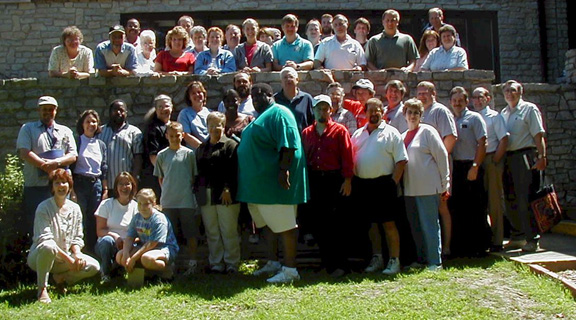Location:
Southeastern Ohio
Within a day's driving distance of: Columbus, Cleveland, and Cincinnati, Ohio; Pittsburgh,
Pennsylvania; Louisville and Lexington, Kentucky; and Charleston and Huntington, West
Virginia.Terrain:
Rolling Appalachian foothills.
Land Status:
The Wayne NF is located in three units. These units are located across
twelve Ohio Counties. Although the boundaries include 833,990 acres, most of
the land within those boundaries is in private ownership. The national
forest exists as a patchwork across the land, normally occupying lands less
suitable for agricultural or commercial development. Click here for
land statistics for the Wayne National Forest.
Unique Features
Vesuvius Furnace - A
partially restored iron furnace built in 1833.
Irish Run Natural Bridge - One of 7 natural rock bridges in Ohio, 51' long, 16' thick and
39' high.
Covered Bridges - Several century old covered bridges are found on the Forest.
Shawnee Lookout Tower - Constructed by the CCC in 1939.
Wildlife:
The mix of openland and forest provides a wide variety of
wildlife habitats. Common
mammals include white-tailed deer, gray fox, woodchuck, opossum, and gray squirrel. Common
birds are turkey, ruffed grouse, pileated woodpecker and wood duck.
Watchable Wildlife:
Ohio has developed a Wildlife Viewing Guide. The guide recommends "watchable
wildlife" sites on the Wayne,
primarily along Forest waterways, where heron, osprey, beaver and otter can be seen. Other
sites featured indicate where upland forest wildlife can be viewed.
Heritage Resources:
Southeastern Ohio is rich in history.
Mounds and prehistoric earthworks from the Adena and Hopewell cultures are still found on
the Forest.
While many towns date back to the first settlements in the Northwest Territory, others are
founded on sites that are even older. Cemeteries and historic buildings on the Forest
offer visitors a glimpse into the past.
Vesuvius Furnace,
Ring Mill House, three covered
bridges, the Shawnee Fire Tower, old oil derricks, and several rock shelters are
interpreted for the public. Significant work has been done through a
special grant on
African-American communities on the Forest. Payments to
States:
National Forests do not pay property taxes but payments in lieu
of taxes are made annually. For payments
to counties information click here. |
Land
Recreation:
Hiking, horseback, mountain bike, and ORV riding trails; hunting; nature study; camping and
picnicking; and scenic drives are all available on the Wayne
N.F. Water Recreation:
Leith Run Recreation Area is popular with boaters and
fishermen alike because of the easy access to the Ohio River. The Little
Muskingum and Hocking Rivers, as well as Symmes Creek, offer opportunities for
seasonal float trips through the Forest.
Panfish, catfish, and bass
fishing opportunities
are
available throughout the Forest. Lake
Vesuvius (143 acres) offers paddle boat and canoe rentals and is within the largest
recreation area on the Forest. Timbre Ridge Lake (100
acres) has a primitive boat access.
Scenic Views:
The Covered Bridge Scenic Byway
on State Route 26 showcases one of Ohio's most beautiful stretches of
highway. Historic barns, covered bridges, and century old buildings dot the
landscape along the route following the Little
Muskingum River.
Natural Resources:
Central Hardwoods, primarily oak and hickory, are predominate in southeastern Ohio. Most
species of pine and hemlock found on the forest are native, but many areas, particularly
previously mined areas have been planted.
The Wayne has a "plant a tree" program to
plant trees in honor of someone on the Wayne NF. To order trees for planting on
your own private property go to the Ohio DNR website at:
http://www.ohiodnr.com/forestry
The Wayne is rich in mineral
resources. The mineral program on the Wayne provides jobs and money to the
local economy as well as returns revenue to the federal government. Click
here for more information on the Wayne NF
minerals program. The Forest also manages
fire on the land, both protecting areas
from wild fire and in some cases carefully burning areas for certain
specified reasons.
Several Special Areas have been identified to manage and protect unique ecosystems. Rock
shelters, bluffs, and coves provide interesting places on the Wayne and are home to many
rare plants. Other items of interest:
Wayne N.F. Offices
Information of interest to visitors
 |


